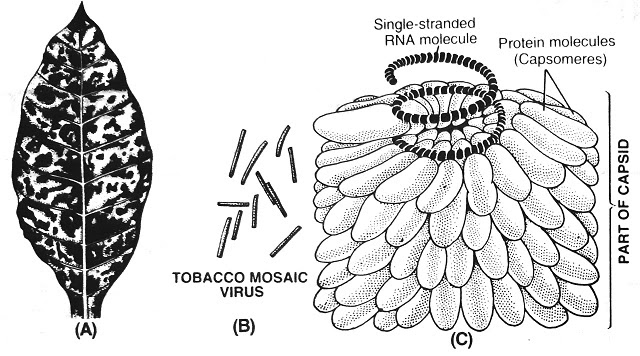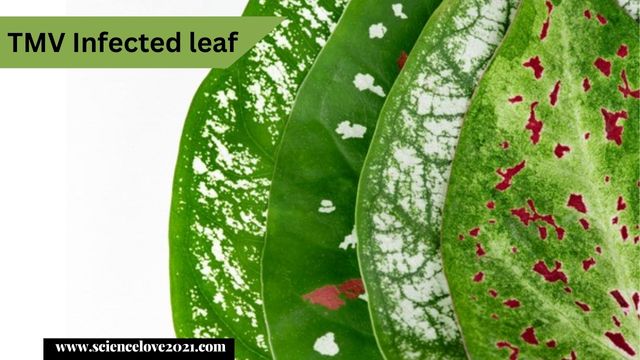Tobacco Mosaic Virus (TMV)
Tobacco Mosaic Virus is More than 100 types of plant viruses that are known to cause various diseases in plants. Tobacco Mosaic Virus has been studied extensively in both field and laboratory. This virus was discovered by D. Iwanowski in 1892, but its isolation from infected plants and crystallization was done by Stanley in 1935.
Symptoms of TMV on the host
TMV infection in the tobacco plant, in first visible symptoms appear in the form of 'downward curling and distortion' of young apical leaves. Large spots of dark green color appear on the upper surface of the leaf, which eventually develops into irregular blistered areas. Other areas of the leaf show typical yellow and green mottling or mosaic symptoms.Read also: Structure and Types of viruses
Structure of Tobacco mosaic virus (TMV)
1. Structure of Tobacco mosaic virus under electron-microscope The particles of this virus appear in the form of rods or needles of approximately 3000 Å in length and 170 Å in diameter and molecular weight of proximately 40 Lakes.2. These particles are made up of two components, a protein coat, and nucleic acid. The protein coat Capsid is made up of approximately 2130 identical protein subunits called Capsomeres. Each of the capsomeres consists of a polypeptide chain of 158 amino acids.
3. The total length of each rod is approximately 130 helices, and each helix contains approximately 16.5 protein subunits. In each helix of RNA, there are 49 nucleotides and the helix has a pitch of 23.
4. All the capsomeres occur around a single-stranded RNA molecule in a helical arrangement.
In each RNA, there occur about 49 nucleotides of a capsid all capsomeres have only one coded gene. The protein and nucleic acid ratio in these particles is 94.4 : 5.6 (single-stranded RNA (5.6%) enveloped by a protein coat (94.4%).
 |
| A. Virus-infected tobacco leaf B. Tobacco Mosaic Virus C. A cultured part of Tobacco Mosaic Virus |
The genetic information necessary for the formation of a complete TMV particle is contained in its RNA. This information determines the Replication of the RNA and sequence of amino acids in the protein subunits of the capsid.
All subunits are identical, Only one coded gene is required for the formation of all capsomeres. It is possible to remove the protein coat from RNA. Then the naked RNA is capable of infecting tobacco plants; once inside the host cell, the virus RNA directs the protein-synthesizing apparatus of the host cell to synthesize its own proteins.
Thus RNA has two functions:
- self-replication and
- synthesis of virus-specific proteins for which it takes the raw material from the host cell.
Life-Cycle (Replication in TMV)
Plant viruses like TMV penetrate and enter the host cells and such complete ingestion is called 'pinocytosis'.1. Inside the host cell, the protein coat is dissolved and viral nucleic acid becomes free in the cell- cytoplasm.
2. Though the sites for different steps of the viral multiplication and formation of new viruses have not yet been determined with absolute certainty, studies suggest that after becoming free in the cell-cytoplasm the viral RNA moves into the nucleus.
3. The viral-RNA first induces the formation of specific enzymes called RNA polymerases.
4. In the presence of these enzymes, the single-stranded stranded RNA synthesizes an additional RNA molecule called 'replicative RNA.
5. This RNA is complementary and serves as a template and starts producing new RNAs which are copies of the parental viral RNA. The new viral RNAs are released from the nucleus into the cytoplasm and serve as messenger RNAs (mRNAs).
Each m-RNA in cooperation with ribosomes and t-RNAs of the host cell induces the synthesis of protein sub-units. Each t-RNA is specific for one amino acid and it is the m-RNA which, by determining the sequence in which the amino acids will be arranged determines the kind of protein to be produced.
After the protein sub-units (capsomeres) have been produced, the new viral nucleic acid is considered to organize the protein sub-units around it resulting in the formation of a complete virus particle, the virion.
No lysis of the host cells, the host cells remain alive and virus particles move from one cell to another cell causing systemic infection. When transmitted by any means they infect other healthy plants.
Control of Tobacco Mosaic Disease
After the protein sub-units (capsomeres) have been produced, the new viral nucleic acid is considered to organize the protein sub-units around it resulting in the formation of a complete virus particle, the virion.
No lysis of the host cells, the host cells remain alive and virus particles move from one cell to another cell causing systemic infection. When transmitted by any means they infect other healthy plants.
Plants that affected by Tobacco Mosaic Virus most
This virus infects over 200 species of plants, but it is most commonly found in members of the Solanaceae family, such as:
- Tobacco
- Tomato
- Pepper
- Eggplant
- Potato
Other plants that are commonly affected by TMV include
- Cucumbers
- Melons
- Spinach
- Lettuce
- Petunia
- Marigold
- Canna
- Begonia
TMV can also infect some weeds, such as groundcherry and jimsonweed.
Control of Tobacco Mosaic Disease
1. Weeding out and destroying diseased plants, their immediate neighbors, and the plants showing suspicious mottling as soon as they pear.
2. Destruction by burning of the mosaic-infected tobacco and tomato crop refuse on land.
3. Through washing hands with 3% trisodium phosphate followed by scrubbing with soap water before handling the plants.
4. Since pipe tobacco, cigarettes, and chewing tobacco are all potential sources of virus infection, the workers in the tobacco field should be furnished with heat-sterilized or mosaic-resistant smoking and chewing tobacco.
5. Removal and destruction of solanaceous weeds, which may be suspected of harboring the virus from the vicinity of tobacco fields.
6. Sterilization of instruments and equipment used in tobacco crop plantations in trisodium phosphate without subsequent rinsing.
7. A variety of tobacco known as Amabalemma, resistant to the mosaic virus has been found. Other mosaic-resistant commercial tobacco have been produced and are being grown.
Treatment of Tobacco Mosaic Virus (TMV)
Once a plant is infected with Tobacco Mosaic Virus (TMV), there is no cure. This virus spreads through infected plants, tools, hand contact insects, etc., and infects various plants like tobacco, tomato, chili, potato, and cucumber.
Various types of symptoms are seen in infected plants, some of which are as follows:
1. Mosaic patterns on the leaves
2. Stunted growth
3. Deformed leaves and fruit
4. Reduced yields
If you suspect that your plants have TMV, it is important to remove them from the garden and dispose of them properly.
There are several things you can do to prevent TMV from infecting your plants:
1. Resistant Varieties of plants should be planted, if available.
2. Wash Your hands thoroughly before and after handling plants.
3. Disinfect your Tools and equipment regularly with a 10% bleach solution.
4. Avoid smoking near your plants.
5. Weeds should be removed regularly as viruses and pests can grow in them.
6. Practice Crop rotation reduces the risk of disease development.
7. Avoid working in the garden in humid conditions, as viruses spread more easily when plants are wet.
8. Do not save seeds from infected plants.
You can also try to prevent the virus from spreading by washing your hands thoroughly after handling infected plants and disinfecting your tools.
FAQs
1. Does Tobacco Mosaic Virus Stay in Soil?
No, the Tobacco Mosaic Virus (TMV) does not stay in the soil. It is a plant virus and cannot survive outside the host plant. However, it can spread through contaminated soil, tools, and clothing.
2. How are viruses spread in plants?
Viruses can be spread in plants in a variety of ways, including:
• Mechanical transmission: This is the most common way that TMV is spread. This occurs when an infected plant comes in contact with a healthy plant, or when contaminated tools or clothing are used on both infected and healthy plants.
• Insect transmission: Some viruses, but not TMV, can be transmitted by insects such as aphids and thrips.
• Seed transmission: Some viruses, but not TMV, can be transmitted through contaminated seeds.
3. How do I get rid of the mosaic virus?
There is no cure for viral diseases in plants. Once a plant is infected, it remains infected for the rest of its life. However, there are some things you can do to prevent the spread of the virus, such as:
- Remove and destroy infected plants.
- Disinfect all tools and equipment before and after use.
- Wash your hands thoroughly before handling plants.
- Plant resistant varieties.
4. How does the Tobacco Mosaic Virus affect humans?
TMV is not known to cause any diseases in humans. However, it is possible to become infected with TMV through contact with infected plants or plant material. If you become infected, you may experience some mild symptoms, such as skin irritation or a rash.
5. Is Tobacco Mosaic a DNA Virus?
No, the Tobacco Mosaic Virus is an RNA virus. This means that its genetic material is made up of Ribonucleic acid (RNA) rather than Deoxyribonucleic acid (DNA).
%20%20Definition,%20structure,%20life%20Cycle.webp)



No comments:
Post a Comment